#include <stdio.h>#include "slu_Cnames.h"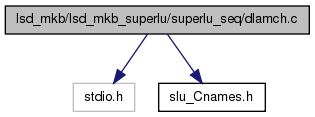
Defines | |
| #define | TRUE_ (1) |
| #define | FALSE_ (0) |
| #define | abs(x) ((x) >= 0 ? (x) : -(x)) |
| #define | min(a, b) ((a) <= (b) ? (a) : (b)) |
| #define | max(a, b) ((a) >= (b) ? (a) : (b)) |
Functions | |
| double | dlamch_ (char *cmach) |
| int | dlamc1_ (int *beta, int *t, int *rnd, int *ieee1) |
| int | dlamc2_ (int *beta, int *t, int *rnd, double *eps, int *emin, double *rmin, int *emax, double *rmax) |
| double | dlamc3_ (double *a, double *b) |
| int | dlamc4_ (int *emin, double *start, int *base) |
| int | dlamc5_ (int *beta, int *p, int *emin, int *ieee, int *emax, double *rmax) |
| double | pow_di (double *ap, int *bp) |
| #define abs | ( | x | ) | ((x) >= 0 ? (x) : -(x)) |
| #define FALSE_ (0) |
| #define max | ( | a, | |||
| b | ) | ((a) >= (b) ? (a) : (b)) |
| #define min | ( | a, | |||
| b | ) | ((a) <= (b) ? (a) : (b)) |
| #define TRUE_ (1) |
| int dlamc1_ | ( | int * | beta, | |
| int * | t, | |||
| int * | rnd, | |||
| int * | ieee1 | |||
| ) |
Purpose
======= DLAMC1 determines the machine parameters given by BETA, T, RND, and
IEEE1. Arguments
========= BETA (output) INT
The base of the machine. T (output) INT
The number of ( BETA ) digits in the mantissa. RND (output) INT
Specifies whether proper rounding ( RND = .TRUE. ) or
chopping ( RND = .FALSE. ) occurs in addition. This may notbe a reliable guide to the way in which the machine performs
its arithmetic.
IEEE1 (output) INT
Specifies whether rounding appears to be done in the IEEE
'round to nearest' style. Further Details
=============== The routine is based on the routine ENVRON by Malcolm and
incorporates suggestions by Gentleman and Marovich. See Malcolm M. A. (1972) Algorithms to reveal properties of
floating-point arithmetic. Comms. of the ACM, 15, 949-951. Gentleman W. M. and Marovich S. B. (1974) More on algorithms
that reveal properties of floating point arithmetic units.
Comms. of the ACM, 17, 276-277.=====================================================================

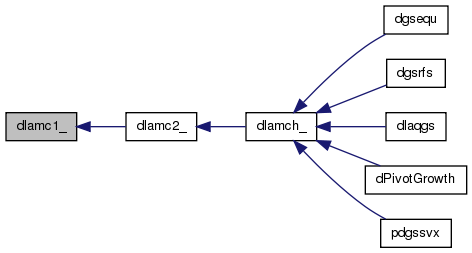
| int dlamc2_ | ( | int * | beta, | |
| int * | t, | |||
| int * | rnd, | |||
| double * | eps, | |||
| int * | emin, | |||
| double * | rmin, | |||
| int * | emax, | |||
| double * | rmax | |||
| ) |
Purpose
======= DLAMC2 determines the machine parameters specified in its argument
list. Arguments
========= BETA (output) INT
The base of the machine. T (output) INT
The number of ( BETA ) digits in the mantissa. RND (output) INT
Specifies whether proper rounding ( RND = .TRUE. ) or
chopping ( RND = .FALSE. ) occurs in addition. This may notbe a reliable guide to the way in which the machine performs
its arithmetic.
EPS (output) DOUBLE PRECISION
The smallest positive number such thatfl( 1.0 - EPS ) .LT. 1.0,
where fl denotes the computed value.
EMIN (output) INT
The minimum exponent before (gradual) underflow occurs. RMIN (output) DOUBLE PRECISION
The smallest normalized number for the machine, given by
BASE**( EMIN - 1 ), where BASE is the floating point valueof BETA.
EMAX (output) INT
The maximum exponent before overflow occurs. RMAX (output) DOUBLE PRECISION
The largest positive number for the machine, given by
BASE**EMAX * ( 1 - EPS ), where BASE is the floating pointvalue of BETA.
Further Details
=============== The computation of EPS is based on a routine PARANOIA by
W. Kahan of the University of California at Berkeley.=====================================================================
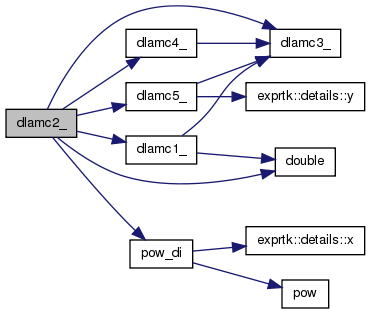
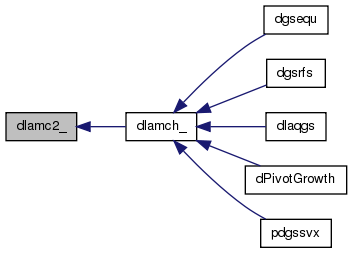
| double dlamc3_ | ( | double * | a, | |
| double * | b | |||
| ) |
Purpose
=======DLAMC3 is intended to force A and B to be stored prior to doing
the addition of A and B , for use in situations where optimizers
might hold one of these in a register.
Arguments
========= A, B (input) DOUBLE PRECISION
The values A and B.=====================================================================
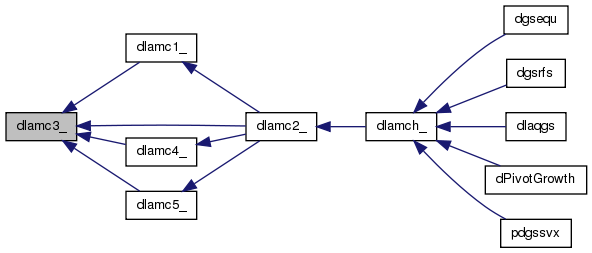
| int dlamc4_ | ( | int * | emin, | |
| double * | start, | |||
| int * | base | |||
| ) |
Purpose
=======DLAMC4 is a service routine for DLAMC2.
Arguments
========= EMIN (output) EMIN
The minimum exponent before (gradual) underflow, computed by setting A = START and dividing by BASE until the previous A
can not be recovered. START (input) DOUBLE PRECISION
The starting point for determining EMIN. BASE (input) INT
The base of the machine.=====================================================================

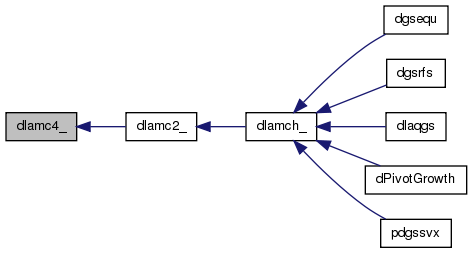
| int dlamc5_ | ( | int * | beta, | |
| int * | p, | |||
| int * | emin, | |||
| int * | ieee, | |||
| int * | emax, | |||
| double * | rmax | |||
| ) |
Purpose
======= DLAMC5 attempts to compute RMAX, the largest machine floating-point
number, without overflow. It assumes that EMAX + abs(EMIN) sum
approximately to a power of 2. It will fail on machines where this
assumption does not hold, for example, the Cyber 205 (EMIN = -28625, EMAX = 28718). It will also fail if the value supplied for EMIN is
too large (i.e. too close to zero), probably with overflow. Arguments
========= BETA (input) INT
The base of floating-point arithmetic. P (input) INT
The number of base BETA digits in the mantissa of a
floating-point value. EMIN (input) INT
The minimum exponent before (gradual) underflow. IEEE (input) INT
A int flag specifying whether or not the arithmetic
system is thought to comply with the IEEE standard. EMAX (output) INT
The largest exponent before overflow RMAX (output) DOUBLE PRECISION
The largest machine floating-point number.=====================================================================
First compute LEXP and UEXP, two powers of 2 that bound
abs(EMIN). We then assume that EMAX + abs(EMIN) will sum
approximately to the bound that is closest to abs(EMIN).
(EMAX is the exponent of the required number RMAX).

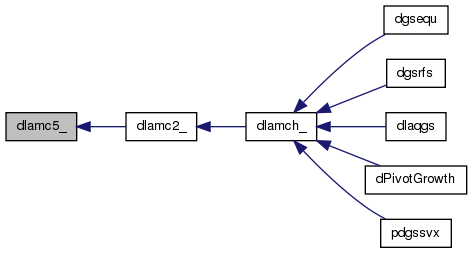
| double dlamch_ | ( | char * | cmach | ) |
Purpose
=======DLAMCH determines double precision machine parameters.
Arguments
========= CMACH (input) CHARACTER*1
Specifies the value to be returned by DLAMCH:
= 'E' or 'e', DLAMCH := eps
= 'S' or 's , DLAMCH := sfmin
= 'B' or 'b', DLAMCH := base
= 'P' or 'p', DLAMCH := eps*base
= 'N' or 'n', DLAMCH := t
= 'R' or 'r', DLAMCH := rnd
= 'M' or 'm', DLAMCH := emin
= 'U' or 'u', DLAMCH := rmin
= 'L' or 'l', DLAMCH := emax
= 'O' or 'o', DLAMCH := rmaxwhere
eps = relative machine precision
sfmin = safe minimum, such that 1/sfmin does not overflow
base = base of the machine
prec = eps*base
t = number of (base) digits in the mantissa
rnd = 1.0 when rounding occurs in addition, 0.0 otherwise
emin = minimum exponent before (gradual) underflow
rmin = underflow threshold - base**(emin-1)
emax = largest exponent before overflow
rmax = overflow threshold - (base**emax)*(1-eps)=====================================================================
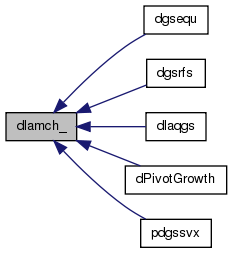
| double pow_di | ( | double * | ap, | |
| int * | bp | |||
| ) |

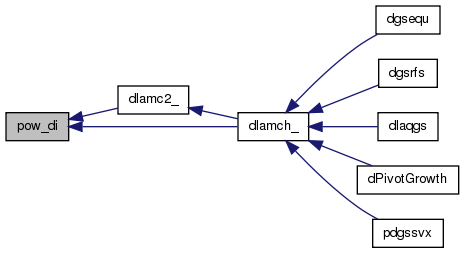
 1.6.1
1.6.1